TOYOTA YARIS HYBRID 2014 Service Manual
Manufacturer: TOYOTA, Model Year: 2014, Model line: YARIS HYBRID, Model: TOYOTA YARIS HYBRID 2014Pages: 464, PDF Size: 23.4 MB
Page 41 of 464

411-1. For safe use
1
For safety and security
WARNING
SRS airbag precautions
Observe the following precautions regarding the SRS airbags.
Failure to do so may cause death or serious injury.
The driver and all passengers in the vehicle must wear their seat belts
properly.
The SRS airbags are supplemental devices to be used with the seat belts.
The SRS driver airbag deploys with considerable force, and can cause
death or serious injury especially if the driver is very close to the airbag.
Since the risk zone for the driver’s airbag is the first 50 - 75 mm (2 - 3 in.)
of inflation, placing yourself 250 mm (10 in.) from your driver airbag pro-
vides you with a clear margin of safety. This distance is measured from
the center of the steering wheel to your breastbone. If you sit less than
250 mm (10 in.) away now, you can change your driving position in sev-
eral ways:
• Move your seat to the rear as far as you can while still reaching the ped-
als comfortably.
• Slightly recline the back of the seat. Although vehicle designs vary,
many drivers can achieve the 250 mm (10 in.) distance, even with the
driver seat all the way forward, simply by reclining the back of the seat
somewhat. If reclining the back of your seat makes it hard to see the
road, raise yourself by using a firm, non-slippery cushion, or raise the
seat if your vehicle has that feature.
• If your steering wheel is adjustable, tilt it downward. This points the air-
bag toward your chest instead of your head and neck.
The seat should be adjusted as recommended above, while still maintain-
ing control of the foot pedals, steering wheel, and your view of the instru-
ment panel controls.
The SRS front passenger airbag also deploys with considerable force, and
can cause death or serious injury especially if the front passenger is very
close to the airbag. The front passenger seat should be as far from the air-
bag as possible with the seatback adjusted, so the front passenger sits
upright.
Improperly seated and/or restrained infants and children can be killed or
seriously injured by a deploying airbag. An infant or child who is too small
to use a seat belt should be properly secured using a child restraint sys-
tem. Toyota strongly recommends that all infants and children be placed in
the rear seats of the vehicle and properly restrained. The rear seats are
safer for infants and children than the front passenger seat. (P. 53)
Page 42 of 464
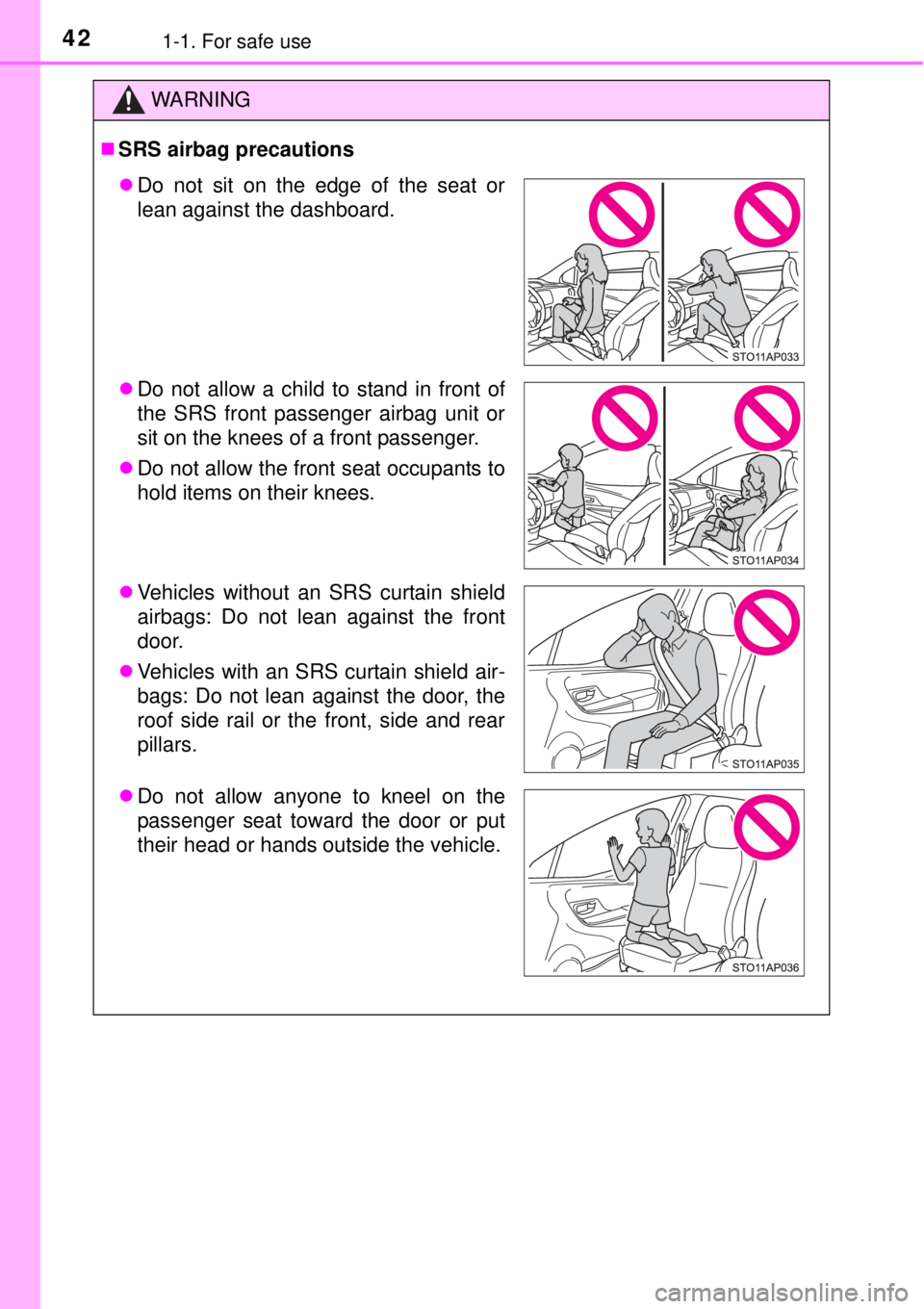
421-1. For safe use
WARNING
SRS airbag precautions
Do not sit on the edge of the seat or
lean against the dashboard.
Do not allow a child to stand in front of
the SRS front passenger airbag unit or
sit on the knees of a front passenger.
Do not allow the front seat occupants to
hold items on their knees.
Vehicles without an SRS curtain shield
airbags: Do not lean against the front
door.
Vehicles with an SRS curtain shield air-
bags: Do not lean against the door, the
roof side rail or the front, side and rear
pillars.
Do not allow anyone to kneel on the
passenger seat toward the door or put
their head or hands outside the vehicle.
Page 43 of 464
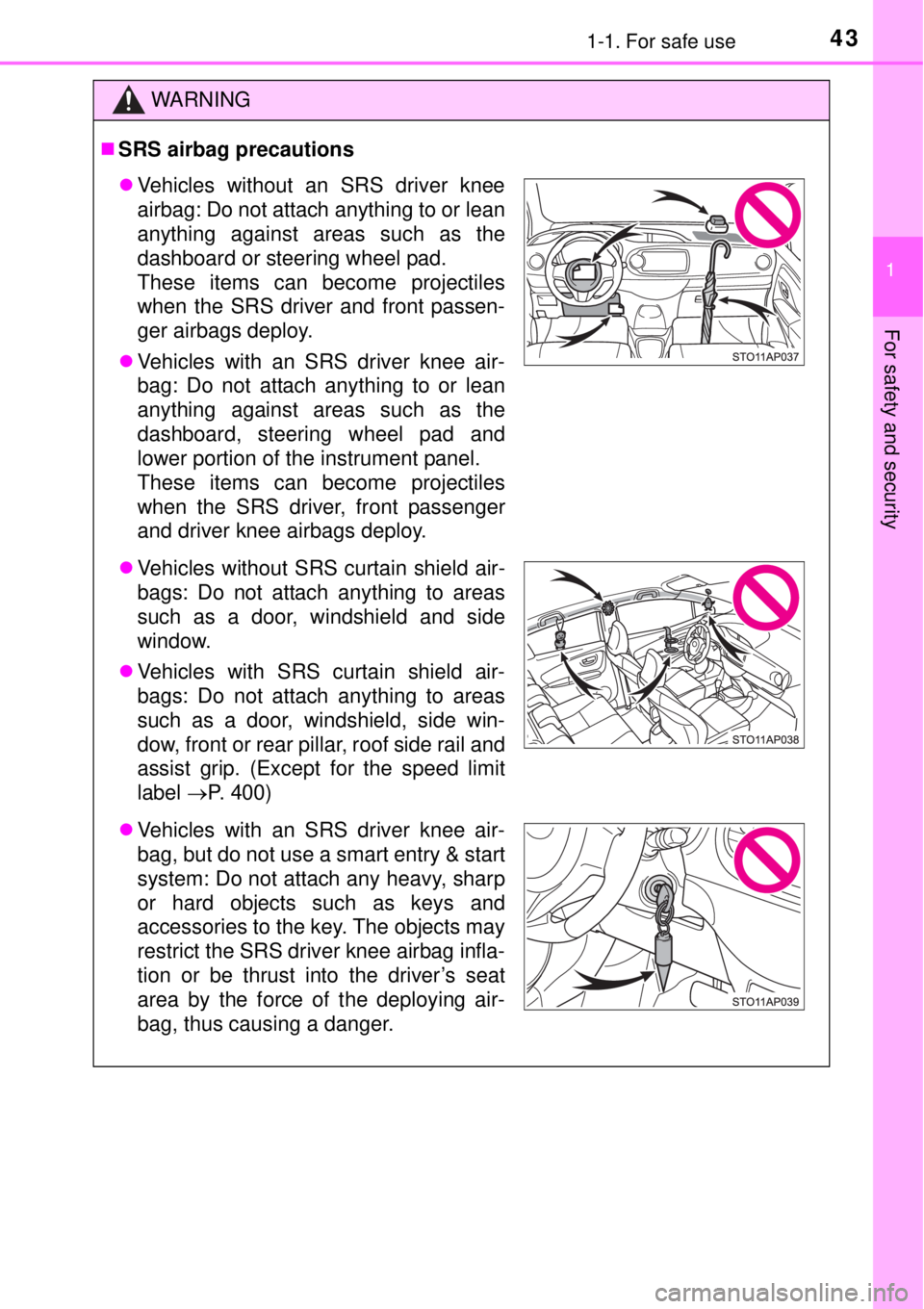
431-1. For safe use
1
For safety and security
WARNING
SRS airbag precautions
Vehicles without an SRS driver knee
airbag: Do not attach anything to or lean
anything against areas such as the
dashboard or steering wheel pad.
These items can become projectiles
when the SRS driver and front passen-
ger airbags deploy.
Vehicles with an SRS driver knee air-
bag: Do not attach anything to or lean
anything against areas such as the
dashboard, steering wheel pad and
lower portion of the instrument panel.
These items can become projectiles
when the SRS driver, front passenger
and driver knee airbags deploy.
Vehicles without SRS curtain shield air-
bags: Do not attach anything to areas
such as a door, windshield and side
window.
Vehicles with SRS curtain shield air-
bags: Do not attach anything to areas
such as a door, windshield, side win-
dow, front or rear pillar, roof side rail and
assist grip. (Except for the speed limit
label P. 400)
Vehicles with an SRS driver knee air-
bag, but do not use a smart entry & start
system: Do not attach any heavy, sharp
or hard objects such as keys and
accessories to the key. The objects may
restrict the SRS driver knee airbag infla-
tion or be thrust into the driver’s seat
area by the force of the deploying air-
bag, thus causing a danger.
Page 44 of 464

441-1. For safe use
WARNING
SRS airbag precautions
Vehicles with SRS curtain shield airbags: Do not hang coat hangers or
other hard objects on the coat hooks. All of these items could become pro-
jectiles and may cause death or serious injury, should the SRS curtain
shield airbags deploy.
Vehicles with an SRS driver knee airbag: If a vinyl cover is put on the area
where the SRS driver knee airbag will deploy, be sure to remove it.
Do not use seat accessories which cover the parts where the SRS side
airbags inflate as they may interfere with inflation of the SRS airbags.
Such accessories may prevent the side airbags from activating correctly,
disable the system or cause the side airbags to inflate accidentally, result-
ing in death or serious injury.
Do not strike or apply significant levels of force to the area of the SRS air-
bag components.
Doing so can cause the SRS airbags to malfunction.
Do not touch any of the component parts immediately after the SRS air-
bags have deployed (inflated) as they may be hot.
If breathing becomes difficult after the SRS airbags have deployed, open a
door or window to allow fresh air in, or leave the vehicle if it is safe to do
so. Wash off any residue as soon as possible to prevent skin irritation.
Vehicles without SRS curtain shield airbags: If the areas where the SRS
airbags are stored, such as the steering wheel pad, are damaged or
cracked, have them replaced by any authorized Toyota dealer or repairer,
or another duly qualified and equipped professional.
Vehicles with SRS curtain shield airbags: If the areas where the SRS air-
bags are stored, such as the steering wheel pad and front and rear pillar
garnishes, are damaged or cracked, have them replaced by any autho-
rized Toyota dealer or repairer, or another duly qualified and equipped pro-
fessional.
Page 45 of 464

451-1. For safe use
1
For safety and security
WARNING
Modification and disposal of SRS airbag system components
Do not dispose of your vehicle or perform any of the following modifications
without consulting any authorized Toyota dealer or repairer, or another duly
qualified and equipped professional. The SRS airbags may malfunction or
deploy (inflate) accidentally, causing death or serious injury.
Installation, removal, disassembly and repair of the SRS airbags
Repairs, modifications, removal or replacement of the steering wheel,
instrument panel, dashboard, seats or seat upholstery, front, side and rear
pillars or roof side rails
Repairs or modifications of the front fender, front bumper, or side of the
occupant compartment
Installation of a grille guard (bull bars, kangaroo bar, etc.), snow plows,
winches
Modifications to the vehicle’s suspension system
Installation of electronic devices such as mobile two-way radios (RF-trans-
mitter) and CD players
Page 46 of 464

461-1. For safe use
If the SRS airbags deploy (inflate)
Bruising and slight abrasions may result from contact with a deploying
(inflating) SRS airbag.
A loud noise and white powder will be emitted.
Vehicles without SRS curtain shield airbags: Parts of the airbag module
(steering wheel hub, airbag cover and inflator) as well as the front seats may
be hot for several minutes. The airbag itself may also be hot.
Vehicles with SRS curtain shield airbags: Parts of the airbag module (steer-
ing wheel hub, airbag cover and inflator) as well as the front seats, parts of
the front and rear pillars, and roof side rails, may be hot for several minutes.
The airbag itself may also be hot.
The windshield may crack.
SRS airbag deployment conditions (SRS front airbags)
The SRS front airbags will deploy in the event of an impact that exceeds the
set threshold level (the level of force corresponding to an approximately 20 -
30 km/h [12 - 18 mph] frontal collision with a fixed wall that does not move or
deform).
However, this threshold velocity will be considerably higher in the following
situations:
• If the vehicle strikes an object, such as a parked vehicle or sign pole,
which can move or deform on impact
• If the vehicle is involved in an underride collision, such as a collision in
which the front of the vehicle “underrides”, or goes under, the bed of a
truck
Depending on the type of collision, it is possible that only the seat belt pre-
tensioners will activate.
SRS airbag deployment conditions (SRS side airbags and SRS curtain
shield airbags [if equipped])
The SRS side and curtain shield airbags will deploy in the event of an impact
that exceeds the set threshold level (the level of force corresponding to the
impact force produced by an approximately 1500 kg [3300 lb.] vehicle collid-
ing with the vehicle cabin from a direction perpendicular to the vehicle orien-
tation at an approximate speed of 20 - 30 km/h [12 - 18 mph]).
Page 47 of 464
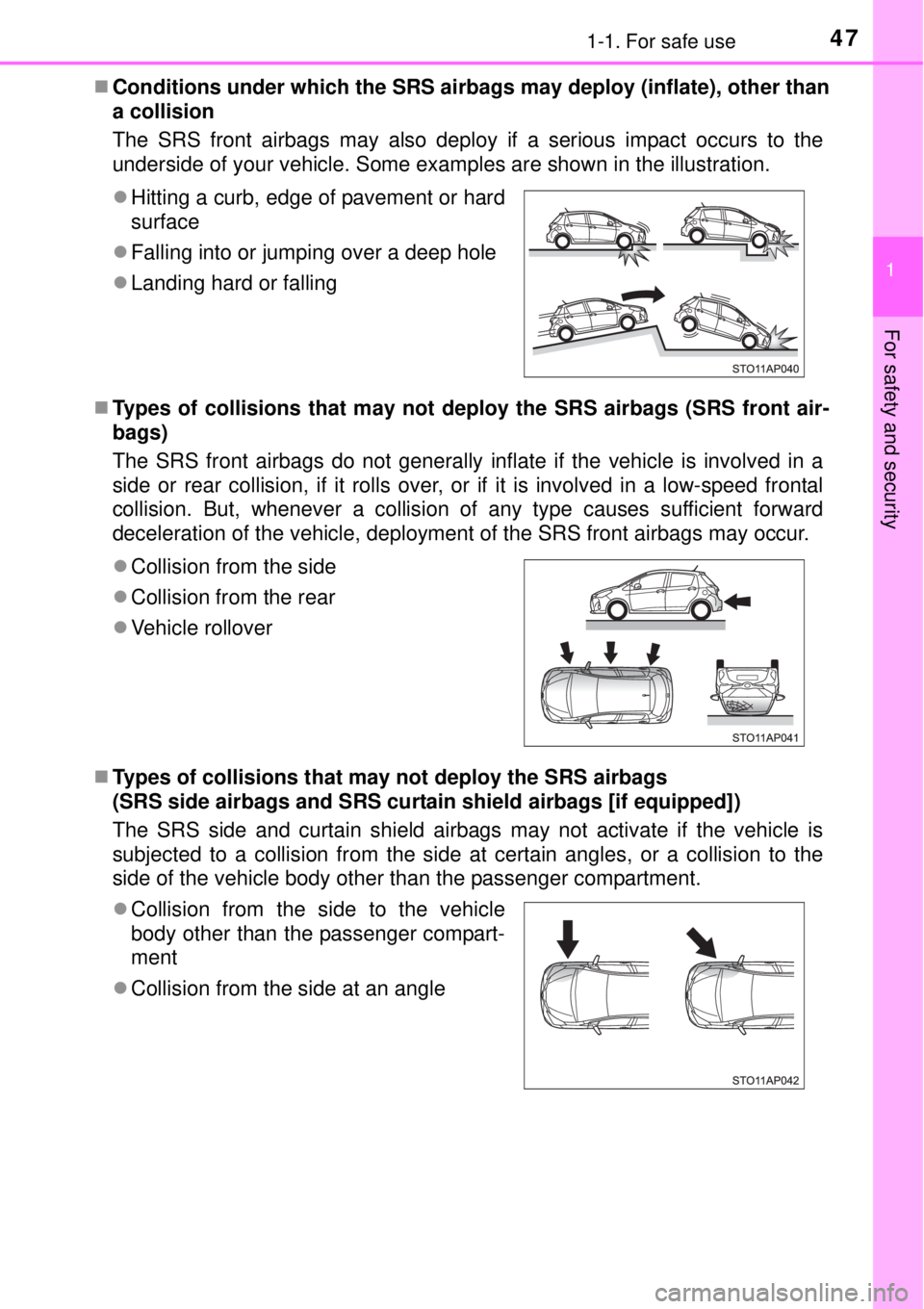
471-1. For safe use
1
For safety and security
Conditions under which the SRS airbags may deploy (inflate), other than
a collision
The SRS front airbags may also deploy if a serious impact occurs to the
underside of your vehicle. Some examples are shown in the illustration.
Types of collisions that may not deploy the SRS airbags (SRS front air-
bags)
The SRS front airbags do not generally inflate if the vehicle is involved in a
side or rear collision, if it rolls over, or if it is involved in a low-speed frontal
collision. But, whenever a collision of any type causes sufficient forward
deceleration of the vehicle, deployment of the SRS front airbags may occur.
Types of collisions that may not deploy the SRS airbags
(SRS side airbags and SRS curtain shield airbags [if equipped])
The SRS side and curtain shield airbags may not activate if the vehicle is
subjected to a collision from the side at certain angles, or a collision to the
side of the vehicle body other than the passenger compartment. Hitting a curb, edge of pavement or hard
surface
Falling into or jumping over a deep hole
Landing hard or falling
Collision from the side
Collision from the rear
Vehicle rollover
Collision from the side to the vehicle
body other than the passenger compart-
ment
Collision from the side at an angle
Page 48 of 464
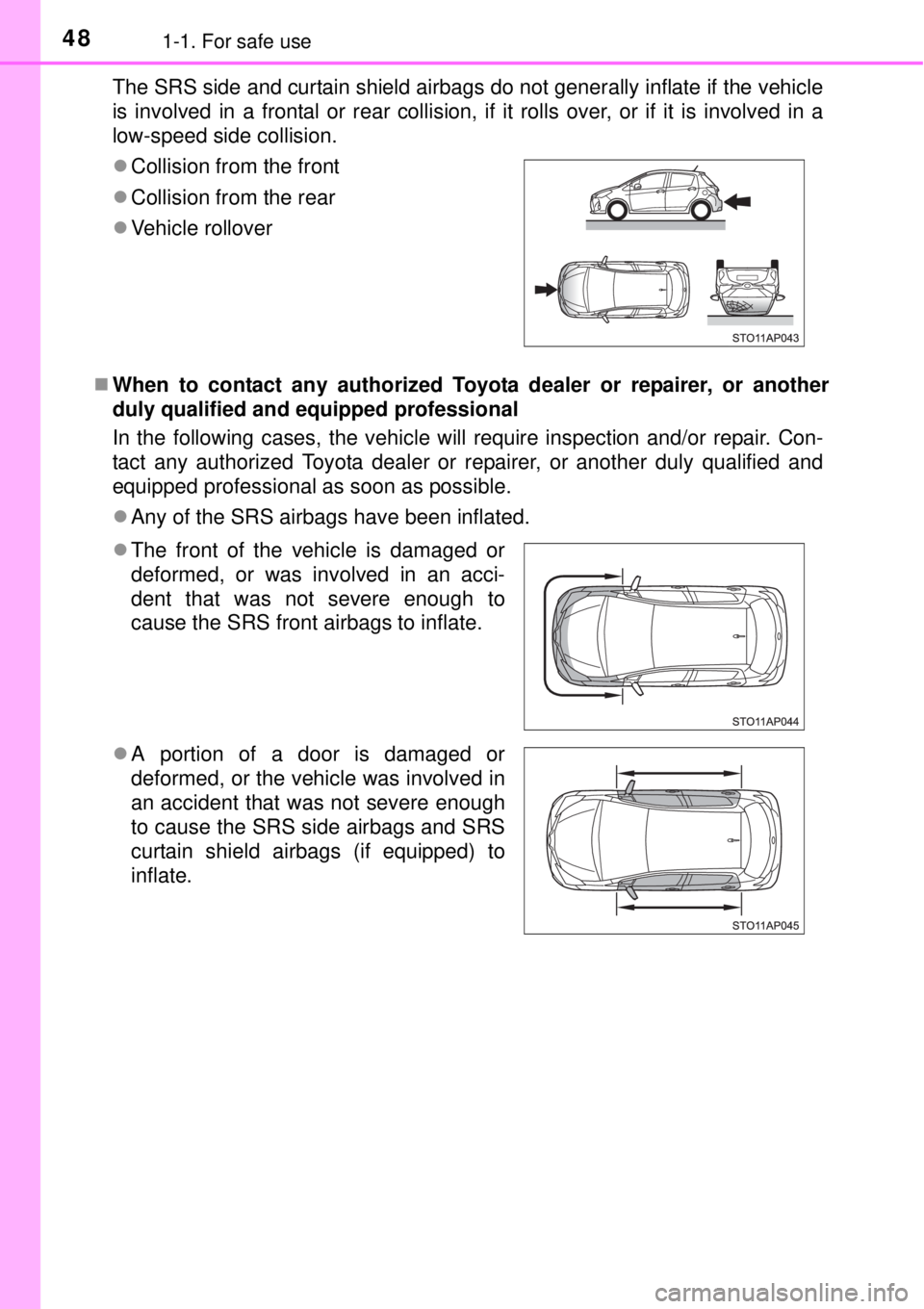
481-1. For safe use
The SRS side and curtain shield airbags do not generally inflate if the vehicle
is involved in a frontal or rear collision, if it rolls over, or if it is involved in a
low-speed side collision.
When to contact any authorized Toyota dealer or repairer, or another
duly qualified and equipped professional
In the following cases, the vehicle will require inspection and/or repair. Con-
tact any authorized Toyota dealer or repairer, or another duly qualified and
equipped professional as soon as possible.
Any of the SRS airbags have been inflated. Collision from the front
Collision from the rear
Vehicle rollover
The front of the vehicle is damaged or
deformed, or was involved in an acci-
dent that was not severe enough to
cause the SRS front airbags to inflate.
A portion of a door is damaged or
deformed, or the vehicle was involved in
an accident that was not severe enough
to cause the SRS side airbags and SRS
curtain shield airbags (if equipped) to
inflate.
Page 49 of 464

491-1. For safe use
1
For safety and security
Vehicles without an SRS driver knee air-
bag: The pad section of the steering
wheel or dashboard near the front pas-
senger airbag is scratched, cracked, or
otherwise damaged.
Vehicles with an SRS driver knee airbag:
The pad section of the steering wheel,
dashboard near the front passenger air-
bag or lower portion of the instrument
panel is scratched, cracked, or other-
wise damaged.
The surface of the seats with the side
airbag is scratched, cracked, or other-
wise damaged.
Vehicles with SRS curtain shield air-
bags: The portion of the front pillars, rear
pillars or roof side rail garnishes (pad-
ding) containing the curtain shield air-
bags is inside scratched, cracked, or
otherwise damaged.
Page 50 of 464
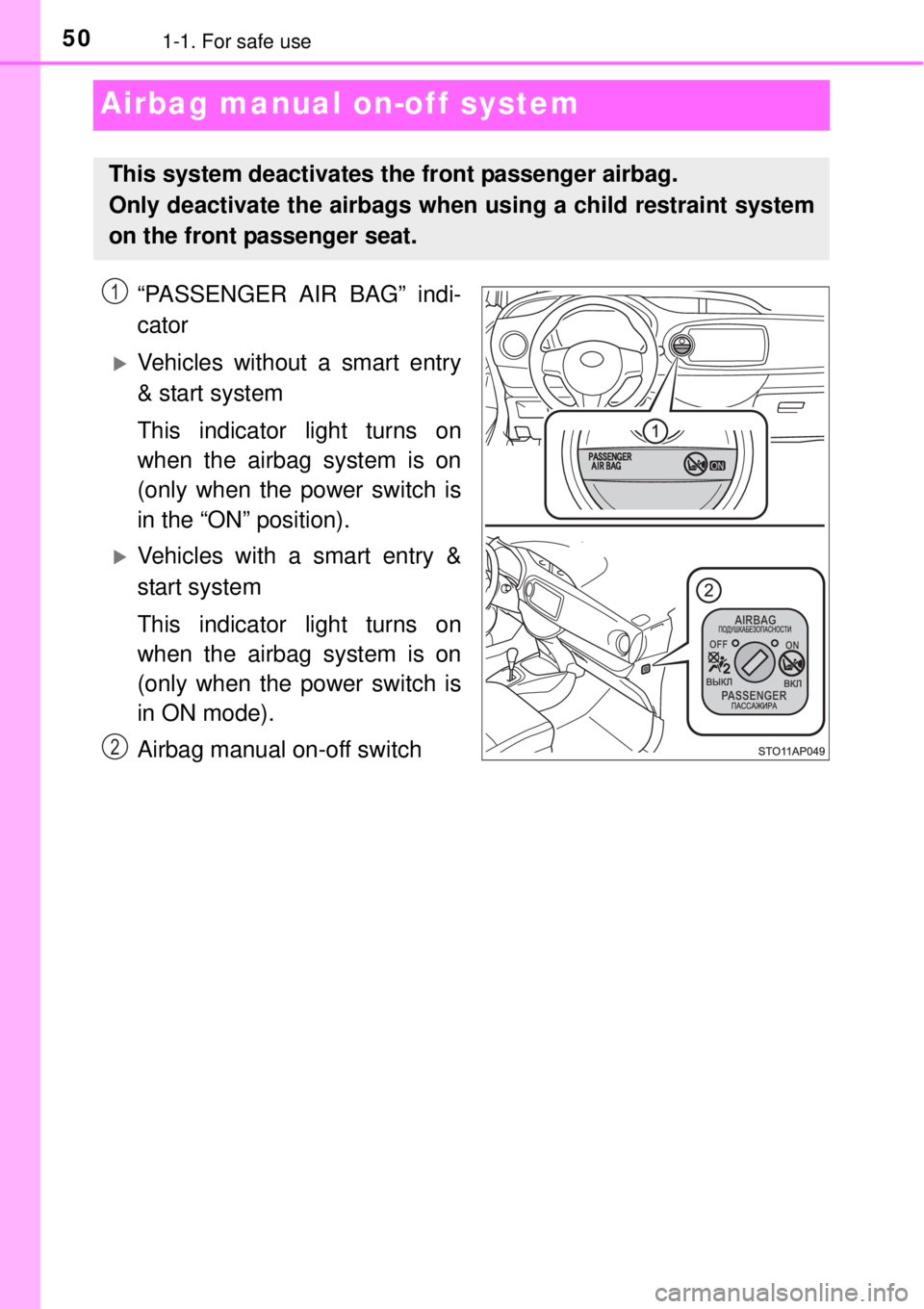
501-1. For safe use
Airbag manual on-off system
“PASSENGER AIR BAG” indi-
cator
Vehicles without a smart entry
& start system
This indicator light turns on
when the airbag system is on
(only when the power switch is
in the “ON” position).
Vehicles with a smart entry &
start system
This indicator light turns on
when the airbag system is on
(only when the power switch is
in ON mode).
Airbag manual on-off switch
This system deactivates the front passenger airbag.
Only deactivate the airbags when using a child restraint system
on the front passenger seat.
1
2